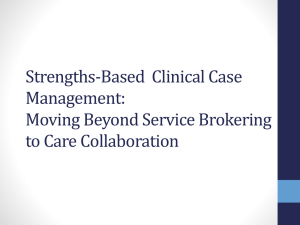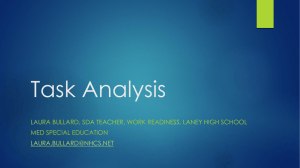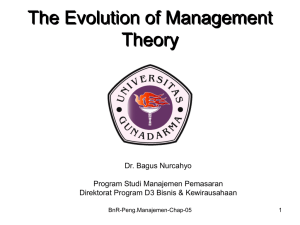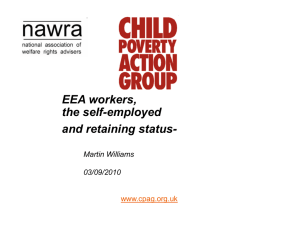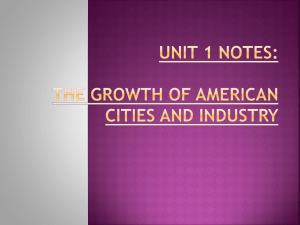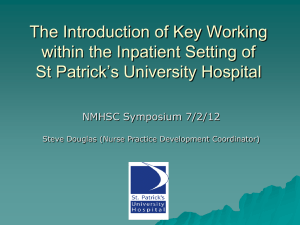Workforce Involvement & the 2012 London Olympic Stadium
advertisement
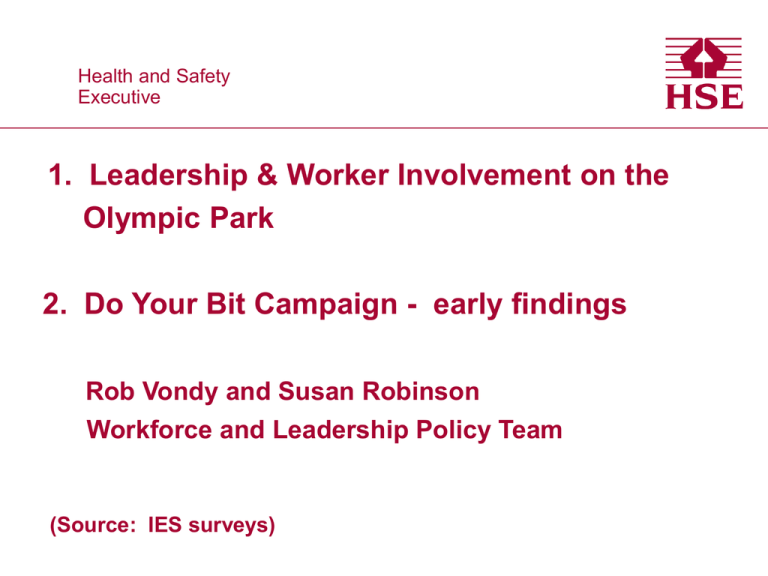
Health Healthand andSafety Safety Executive Executive 1. Leadership & Worker Involvement on the Olympic Park 2. Do Your Bit Campaign - early findings Rob Vondy and Susan Robinson Workforce and Leadership Policy Team (Source: IES surveys) Worker Involvement on the Olympic Park Study aims • To understand approaches to leadership and worker involvement on the Park, and the impact of these on attitudes and behaviours associated with positive health and safety practices and performance • Transferability of lessons learnt ODA HS & E Leadership Model Summary of key findings • Vision - A strong commitment to health, safety and well-being incorporating a clear statement of expectations and standards as a key priority • Action - Vision was translated into action through creating an array of levers to engage Tier 1 and Tier 2 contractors • Engaging the supply chain – work with and through contractors to develop a collaborative approach across the site • Monitoring – performance against both the vision and standards • Structure –involved all layers – HS&E Leadership Board, SHELT, Project Leadership Teams - embedded throughout the management chain Summary of key findings • Communication – structure was supported by effective and innovative communications at all levels • Learning – learning was embedded into the culture through ensuring that it was encouraged and sustained – focus on safety controls and hazard awareness • Employee engagement – focus on employee wellbeing, health care, reward and recognition, encouragement of near miss reporting and a culture of openness and “fair blame” Worker Involvement Key components Comprehensive H&S inductions Mandatory Daily Activity Briefings (DABs) Safety Stand-downs - “Take time for safety” Visibility and accessibility to Leadership teams Involvement of Management and Supervisors Tool box talks Verbal and written communications Worker Involvement Key components Climate Survey for feedback and action Personalized posters Good safety practice recognised – breakfast vouchers, branded badges, fleeces and H&S awards “You said, we did” boards Encouragement of open feedback and challenge Behavioural safety initiatives Worker survey • • • • • 45 per cent of site operatives report making a suggestion on how to improve health and safety 31 per cent of site operatives say they have reported a near miss 83 per cent of site operatives report feeling comfortable raising health and safety issues 89 per cent of workers on the Park who reported a near miss were satisfied with how it was dealt with Contractors' report taking learning from the Park to their own organisations Based on an IES survey of 518 workers (of which 336 were site operatives) across three canteens on the Park. ri sk s aspec ts c onsulted of w or k oc cu rs n m an H &S y iss tr ai ni ng po l ic ie s es d ag e pr oc ed ur is m du re s pr oc e ne ar sm en ts w el lbe in g sa fe t ai d fe ty d an ni ng lt h Pl an He a sa ne w Fi rs t d an of ow as se s w he n al ris k ta ke n ri sk s he al th y Ac tio n Ge ne r an d if in c ea lth na lh s to s pr ec au ti on id en t d an ss m en ts tio n au Li ke l Ho w y as se Pe rs o Pr ec Ri sk s Li ke l percentage yes Workers consulted 90 80 70 60 50 40 30 20 10 0 Accident Frequency Rate (AFR) October 2005 – January 2012 (AFR 0.16, 1 yr 0.15) AFR since October 2005 0.90 0.80 0.70 0.60 0.50 0.40 0.30 0.20 0.10 0.00 Safety outcomes for the Olympic Park • By June 2011 the Olympic Delivery Authority (ODA) recorded around 62 million man hours worked, with an accident frequency rate (AFR) of 0.17 (calculated per 100,000 hours worked) • • No accident-related fatalities In addition, 22 periods of one million man hours have been worked without a RIDDOR-reportable injury accident The ODA Business Case Business case rationale • • • • • Productivity – workers healthy, happy and here Recruitment and retention Reputational risk Prevention rather than litigation Off-site time loss kept to a minimum Transferability • • • • Unique? (kudos, one site, resources) • Dependent on size, complexity, resolve, unity of purpose and commitment from the top and throughout the management structure Enablers – processes not always complex or costly Barriers – costs, cultures, reporting Principles transferable eg dialogue, learning from incidents, creating clarity, engaging contractors Learning Legacy • Independent evaluations • Case Studies • Tools and Products www.london2012.com/learninglegacy 14 HSE Strategy HSE strategic goal Involving the workforce “ To reinforce the promotion of worker involvement and consultation in health and safety matters throughout unionised and non-unionised workplaces of all sizes”. Worker Involvement • HSE is committed to promoting the importance and benefit of worker involvement and consultation • This commitment is reflected in our approach to delivery of Worker Involvement Training Programmes and our inspection and enforcement activity • The development of a new Inspectors Topic Pack in consultation with the TUC Evaluation of the Worker Involvement Training Programmes – pilot study Early findings are positive: • Both new reps and joint training courses fulfilled the aims they set out to achieve • 94% of respondents from the new reps course agreeing with the perceived benefits of the course, including better understanding, influencing and communication skills • Delegates on the joint line manager and rep training reported increasing confidence to tackle issues, greater cooperation and an increased awareness of H&S issues (A longitudinal evaluation of the training, by IES, is due to report in the Autumn of 2012) Evaluation of the Worker Involvement Training Programmes – pilot study Joint training delegates either strongly agree or agree that the interventions have: • • • Helped to identify or implement health and safety improvements Established a more collaborative and constructive approach Led to the development of a realistic plan of action to help maintain momentum and sustain improvements agreed (A longitudinal evaluation of the training, by IES, is due to report in the Autumn of 2012) Worker Involvement “It’s all about having conversations with those closest to the job to help you manage health and safety in a practical way” This helps to: • • • spot workplace risks make sure health and safety controls are practical increase the level of commitment to working in a safe and healthy way Worker Involvement Thank you. Any questions…………?

